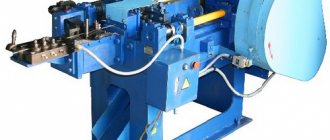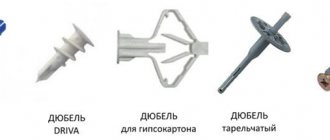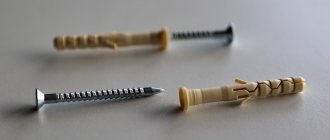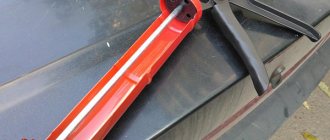by Alexey | Tools Tips Decor Workshop | Monday, July 29, 2019
| Follow Make-Self.net on Facebook and be the first to read our articles. |
It's hard to find a DIYer who doesn't use nails in his projects. It is even more difficult to find a person who understands all types of nails and their uses. Today we want to take you one step further into the “charming world” of nails and tell you about 11 of the most common types of nails and where to use them .
Finishing nails
Used for finishing work. The barrel-shaped heads of these nails are small and can be recessed under the surface of the wood. These nails are useful for attaching lightweight decorative items, repairing small wood pieces, and other times when you need to hide the nail head.
Larger finishing nails, which have increased holding capacity, are used to attach door and window casings, baseboards and lining.
How to choose the nail size
The size of the fastener must be appropriate for the work to be done. The body length, shape and size of the cap are important.
- Having decided on the type of product, select the required length. This is the main distinguishing feature. The length is indicated in millimeters. On average, the longer the rod, the more secure the mount.
- The optimal length is 3 or 4 times longer than the thickness of the material being nailed. When choosing slate products, the length is selected taking into account the height of the ridge.
- The thickness of the nail should be no more than ¼ of the thickness of the part being nailed and no more than 1/10 of the width.
Example: to nail a board 25 mm thick and 150 mm wide, you need a nail 75–100 mm in diameter and no more than 7.5 mm in diameter. If you need to nail a 50*50 mm block, take a nail 150 mm long and 5 mm in diameter.
For the same dimensions, screw and threaded products can withstand higher loads.
Take into account the shape of the cap. Flat and wide helps to hold soft materials like wallpaper or fabric upholstery. Small heads are only suitable when fastening dense, hard wood that is not in danger of cracking.
Dowel-nails
This type of nail has a metal shaft with a smooth surface without threads. The fastener itself is made of metal and expands in the wall hole during driving using a specialized tool. Fastenings using a metal dowel-nail are quite difficult to dismantle, so they require a long service life.
Such nails are used when installing suspended ceilings and all kinds of metal frames.
Carpentry and furniture nails
Carpenter's nails, also known as cladding or trim nails, were specifically created for decorative work. They are characterized by a long head of a semicircular (usually) shape and a small diameter.
This shape makes the nails almost invisible after driving - so we can use them to install decorative strips, panels and visible furniture elements.
Corrugated nails
The nails have special transverse notches on the metal rod, evenly applied over the entire surface. The corrugated nail is designed to increase the strength of the connection due to notches that do not allow the hardware to reverse. Designed for reliable, high-strength connections when installing wooden structures such as plywood, OSB and others.
Production technology
By the end of the 19th century, forged nails were the subject of an extensive cottage industry. Production, as a rule, consisted of the following: a worker took an iron rod, heated it in a forge, and with hammer blows pulled it back on an anvil, sharpening it at the end and leaving a thickening in place of the future head. Then the rod at the head was cut off and inserted into a block with a hole (nail), after which the nail head was flattened with a hammer. Master nailers achieved considerable speed in making nails, managing to forge two nails while the rod was cooling, and a certain James Leiston in Birmingham forged 17 thousand nails in two weeks.
In other cases, the nails were cut from an iron strip (crutches). The technology involved cutting such a strip first into transverse strips with a width equal to the expected length of the crutch, and then lengthwise into separate pieces (diagonally so that one end was pointed) to obtain longitudinal fibers in the crutches themselves. Then the blunt side was bent in the nail maker to form a head. Crutches, with their narrow heads, are used in carpentry.[3]
The same operations subsequently began to be performed by machines. Nails were forged from hot iron and from cold iron. Cast nails were made from cast iron and annealed.
Modern nailing production typically uses rotary presses; Most stages of the manufacturing process, right down to deburring and anti-corrosion coating, are automated. In the 1980s, the length of factory-made nails varied from 6 to 250 millimeters, and the thickness from 0.8 to 8 millimeters[2].
Screw nails
It has a curved rod with edges, as if twisted along its length. Used to connect wooden surfaces with increased levels of pull-off and bending loads. This type of nails is also used in the construction of structures with high levels of humidity, for example, piers, as well as in frame house construction and for the exterior finishing of buildings with wood.
Material of manufacture, waterproof properties
Depending on the presence of a protective anti-corrosion coating, they are divided into those intended for internal or external use.
Even in the photo of nails, you can easily determine water resistance: products without anti-corrosion protection are made of black steel. When exposed to moisture or in a damp room, they quickly show signs of corrosion.
Protective treatment consists of covering the surface with an aluminum, copper, brass or zinc layer (spraying), after which they are not harmed by humidity and water ingress, so they are used for external work.
Double head nails
A double head nail is a variation of a regular nail. It is used to create temporary structures, such as collapsible greenhouses, scaffolding, and temporary ladders. An interesting nail design, the bottom head of which holds the material in place. Subsequently, the nail can be easily pulled out without breaking the structure.
Follow us on Pinterest for more inspiration.
Useful short videos from Make-Self.net
Tips for use
When driving any nail, you must first “bait it”: holding it with two fingers and lightly tapping the head, secure the pointed part. Only after this can blows be struck with full force, until the structure is completely entered. You can also “bait” a nail by inserting it into a small pre-drilled hole.
To prevent the nail from bending, you can hold it by the middle part of the rod with pliers; if this does not help, you need to choose a stronger one, or use a dowel.
To increase the strength of the connection, nails should be driven in at a slight angle to the surface. The thin part should be nailed to the thick part, and only 1/3 of the length of the rod should be in the part being nailed, and the rest in the part being nailed to. It is not recommended to cut off the excess part of the rod, but rather bend it, or unfold it and then drive it into the material.
Remove nails using nail pullers or pliers. You need to place a block under the heel of the nail puller so as not to leave a mark on the surface of the base material. You can also use pliers to remove the nail by grasping it tightly and removing it by rotating alternately in different directions around the axis of the rod.
When looking through the catalog of the best nails, you should remember that it is necessary to provide in advance their appropriate types for all upcoming types of work, and then the repair or construction will be carried out easily, efficiently and quickly!
Advantages of nails for different types of work
Visually, everyone can choose the nail option for their own needs. This is due to several useful qualities of the fastening material:
- versatility (suitable for fastening all components without exception, the main thing is that the nails are chosen correctly);
- a wide range of fasteners, from which you can choose not only the length and thickness of the material, but also its most suitable appearance;
- ease of use, because driving nails into any type of base does not require special skills;
- ease of installation, which consists in the fact that in addition to a hammer, you can use other available means to create a reliable fastening of two elements to each other;
- the ability to fasten two or more parts, provided that the length of the nail allows this;
- long service life (even if the fastener head rusts, the internal part will continue to perform its function in the same rhythm).
Based on the positive qualities, we can come to the conclusion that in home and any other types of conditions, there is always a use for standard nails.
Construction type medium length steel nails Source sense-life.com
To manufacture standard nails for construction and repair, low-carbon steel is used, namely general-purpose wire that meets the GOST 3282-74 standard. In this case, only wire that has not been previously thermally treated is required.
To produce the declared type of wire, factories try to use special steel grades: ST 1 KP, ST 2 KP, ST 3 PS and ST 3 KP. Next, the whole process is carried out as follows:
- A coil of steel wire of appropriate marking according to GOST is loaded into a special automated machine.
- The next step is that the raw material falls under special elements that ensure perfect straightening of the wire.
- Then the straightened material enters the feeding mechanism, where the process of forming the fastening material actually begins.
- The device sets the operating speed of the device, which actually determines the length of the future fastening material.
- The next step is to move the wire towards the wire cutters. They are configured so as not only to bite off the element, but also to create a certain pointed angle (no more than 40 degrees).
- In this way, it is possible to form a tip, after which the opposite end of the wire is struck with a special mechanism.
- A cap is formed. Next, the striking device is withdrawn, the nail falls into the receiver, and the wire processing process is repeated.
The production of nails occurs quite quickly. How much fastening material will ultimately be released from the machine depends on the length of the wire coiled.
Coils of low-carbon steel wire for making nails Source metallograd-34.ru
FAQ:
— What is better to use when building a frame house – nails or self-tapping screws?
The main fastener in frame house construction is a nail (smooth, screw, rough), since a self-tapping screw does not have sufficient structural strength. You can also use special structural self-tapping screws, which are highly resistant to destruction, but they cost 5-10 times more than nails, so their use is not economically viable.
Smooth, rough, screw
Regular yellow screws can be used when assembling the frame, but only with perforated fasteners. The corner joint will hold shear loads just as well as nails. But again, this is an expensive method - each rack will require four corners: two at the bottom and two at the top. And this is already additional expenses.
A rough nail with a conical head is excellent for attaching perforated joist supports and beam supports. It has a high holding capacity and can withstand large shear loads, and its conical head wedges into the perforated holes of the supports, so that such fasteners are not in danger of breaking.
— What is the best way to fasten a wooden roof sheathing?
To fasten the roof sheathing and counter-lattice, you can use both screws and nails, recessing them by 2 mm. Both must be galvanized. But it should be remembered that if the rafter system is insufficiently rigid or if insufficiently dried lumber is used, a smooth nail can come out over time and, coming into contact with the roofing, damage it. The best option is galvanized rough nails, which are highly resistant to tearing out.
— Fasteners for OSB: nail or screw?
OSB board is a universal material that can be attached to a wooden frame with both self-tapping screws and nails. When choosing between them, you need to take into account the installation location and the load on the slab. For example, if this is the future foundation for a soft roof, then high-quality fastening of OSB to the rafters can be achieved using ring or spiral nails, or yellow structural screws.
When cladding a frame house with OSB sheets, you should use nails, not self-tapping screws. This is due precisely to the fact that nails are more resistant to the “walking” of OSB panels. The length of the fastener is selected based on the thickness of the slab plus 5 cm for installation in a wooden frame.
“Is it possible to attach OSB to black self-tapping screws?” — It is possible if the slab is used to create internal partitions or decorative decoration of premises. But we are only talking about high-quality black wood/plasterboard screws. Experienced craftsmen distinguish them visually by a reinforced base under the head, a sharper tip, and a clear and fairly deep slot. The use of low-quality, low-strength analogues can lead to the head being torn off.
Sheathing with OSB board and black screws
Frame and finishing
The staples vary in back width and length, up to 65 mm. The main application is sheet materials plywood, osb, hardboard, metal strips for wood, furniture tape, assembling boxes. Tricky use - piece parquet, finishing floorboard in a tenon, lining in a lock, targeting thin metal.
Bottom line : aluminum staples are the cheapest and the best choice for simple tasks. If high humidity is expected in the room, then for reliability it is better to choose a galvanized or even copper bracket. Steel and stainless steel perform best when fastened to the most durable materials.
There are different types of staples...
If the classification among nails for nailers is quite simple - they are divided into types according to the shape of the cassette / purpose, then with staples for pneumatic staplers it is somewhat more difficult to draw such a clear line. Our store’s assortment currently (March 2021) includes 9 types of nailer staples.
Conventionally, they can be divided into 3 types: upholstery, frame, specialized. Moreover, some types of staples can belong to two types at once.
upholstery bracket 95 type
frame bracket Senco
corrugated cardboard staple
Upholstery staples : narrow staple 92 type, upholstery staple 80 type, upholstery staple 95 type.
Frame (finishing) brackets : narrow bracket type 90, narrow bracket type 92, medium bracket type Senco N, medium bracket type Haubold KG, wide bracket type WS.
Specialized brackets : corrugated cardboard bracket type A, corrugated bracket type Senco-X, crimp bracket C-Ring.
Upholstery staples
Used for assembling furniture, wooden doors, fixing thin films of wind and vapor protection. A furniture stapler easily drives a staple into 16 mm oak. Upholstery staples are an extremely cheap consumable material, so they are aimed at production.
Bottom line : the use of this type of staples is very wide and there is no particular point in describing each of the operations. I just want to note that Type 80 is the most popular because it is made in Russia and, as a result, costs much less.
What materials are hardware made from?
Nails are divided according to purpose, length, diameter and conditions of use, and are also made from different alloys. One material prevents corrosion, which means it can be used outdoors, another will firmly connect wooden parts, and the third will have a beautiful cap that will not disturb the beautiful design of the room.
What are fasteners made of and where are they used:
- Black steel. They are used for fastening wooden elements of temporary structures and indoors. Metal without corrosion protection, when used outdoors, quickly becomes covered with rust, smudges form on the surface, and the nail is destroyed relatively quickly.
- Cink Steel. The cost of such products is a little more expensive, but they are not subject to corrosion and are designed for any type of work, regardless of the conditions of use. When fastening with galvanized hardware, you need to take into account that low-quality products, when exposed to moisture, can also begin to rust.
- Steel coated with brass or copper. Involves the use of nails in the most difficult conditions or for decorative purposes. The coating completely protects the metal from corrosion and oxidation, so the service life of such products is unlimited. Brass and copper also have a similar shade to wood, which allows them to be used when covering surfaces with clapboards.
- Aluminum. Rarely used outdoors, but more often indoors. When exposed to moisture, the nail quickly becomes coated with oxide, which gives the head an unsightly appearance. But when oxidation occurs, the metal is no longer afraid of anything and such fasteners can last for many years.
When choosing fasteners, experts recommend purchasing nails not according to price, but according to the conditions of use. Coating with zinc, brass and copper costs a little more, but eliminates the appearance of rust, which destroys not only the metal, but also the material with which it comes into contact.
Methods for driving nails into material
When performing work on a large scale, it is better to use pneumatic equipment - this will save effort and time. For mounting guns, nails are packaged in special cassettes that are inserted into a drum. Pneumatic equipment shoots hardware under pressure and fixes it in the right place. When using a gun, you must strictly follow safety precautions to avoid injuries and accidents.
If the work is carried out with a hammer, then you need to follow one rule: the larger the nail, the heavier the hammer must be in order to drive the fastener with several blows to the head.
In construction stores you can purchase four types of tools for working with this type of hardware. Handle length 25-37 cm and weight 0.25-1.0 kg. A hammer with a handle length of 30-32 cm and a weight of 0.5 kg is considered a multi-purpose tool. It can work with any size of fasteners, with the only exception being small hardware used in shoe repair and furniture upholstery.
Summarize:
- Assembly with nails is faster and more convenient.
- The nail is more flexible, so if there is an excessive load on the cut, it bends, but “holds.”
- A nail is much less likely to cause cracks in the material.
- The nail is less susceptible to rusting and destruction due to corrosion.
- Nails are cheaper than high-quality self-tapping screws.
- Self-tapping screws are more resistant to pull-out loads.
- The screws can be unscrewed.
- In most cases, self-tapping screws require drilling.
- Working with a screwdriver is easier, but a nailer requires more skill.
When choosing between these two groups of fasteners, the most important factor is the type of load to which the connection is subjected.
When the force is applied to the fastener along its axis - to pull out - a self-tapping screw is the best choice, but in situations where the force is applied across the axis (to shear), a nail is the best choice.
Micropin and micronail
I don't see much point in separating these two types of expenses into two different subsections. Their only difference is the absence or presence of a cap. They are used for the same work and are made from wire of the same section.
Micropin is a very common fastener for installing doors and fixing decorative elements in furniture production. Cured, when it enters the material, the glue heats up and strengthens the fixation of the pin in the material. Available in sizes from 12 to 50 mm, cross section 0.64 mm. International Marking 23 Ga.
Micronail - has the same cross-section as a 0.64 mm micronail, but it has a small head of 0.9 mm, which enhances its load-bearing capacity for decorative elements made of soft wood. Fastening thin elements made of dense wood, such as 5 mm layout or slats, is best done with a micronail.
Bottom line : the only significant difference in using a pin or nail will be the aesthetic aspect of the visibility of the fastener. If the fastener should not be noticeable, use a micropin and rub the hole with carpenter's wax.
Despite the fact that nailers, in most cases, the tool is specialized for one of the types of consumables. There are also combined models for: nail, staple and micropin.
Highly specialized types of fasteners
Not very often found in stores and quite an unusual expense for many. Some people like it, some don’t, but it deserves a special mention.
Galvanized fasteners for assembling gabion structures. High stability and tensile strength of fastening. The staple is suitable for knitting reinforcing mesh.
Nail for a parquet gun for working with natural parquet 20 mm or more. Used for laying sports wooden flooring under basketball courts.
This is where our story about the types of consumables for nailers ends. You can find out about the compatibility of your gun model with the above nails, staples, micropins and micronails in the relevant sections of the site, or by consulting with our managers by phone: +7 (495) 646-09-20,.











